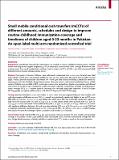Small mobile conditional cash transfers (mCCTs) of different amounts, schedules and design to improve routine childhood immunization coverage and timeliness of children aged 0-23 months in Pakistan: An open label multi-arm randomized controlled trial
Author(s)
Chandir, Subhash; Siddiqi, Danya Arif; Abdullah, Sara; Duflo, Esther; Khan, Aamir Javed; Glennerster, Rachel; ... Show more Show less
DownloadPublished version (1.061Mb)
Publisher with Creative Commons License
Publisher with Creative Commons License
Creative Commons Attribution
Terms of use
Metadata
Show full item recordAbstract
Background: Cost-effective demand-side interventions are needed to increase childhood immunization. Multiple studies find tying income support programs (≥USD 50 per year) to immunization raises coverage. Research on maximizing impact from small mobile-based conditional cash transfers (mCCTs) (≤USD 15 per fully immunized child) delivered in lower-income settings remains sparse. Methods: Participants in Karachi, Pakistan, were individually randomized into a seven arm, factorial open label study with five mCCT arms, one reminder (SMS) only arm, and one control arm. The mCCT arms varied by amount (high ∼USD 15 per fully immunized child versus low ∼USD 5 per fully immunized child), schedule (flat versus rising payments over the schedule), design (certain versus lottery payments), and payment method (airtime or mobile money). Children were enrolled at BCG, pentavalent-1 (penta-1) or pentavalent-2 (penta-2) vaccination and followed until at least 18 months of age. A serosurvey in 15% sub-sample validated reported study coverage. The full immunization coverage (FIC) at 12 months (primary outcome) was analyzed using logit regression. ClinicalTrials.gov (NCT03355989), 3ie registry (58f6ee7725fc1), and AEA RCT Registry (AEARCTR-0001953). Findings: Between November 6, 2017, and October 10, 2018, a total of 11,197 caregiver-child pairs were enrolled, with 1598-1600 caregiver-child pairs per arm. FIC at 12 months was statistically significantly higher for any mCCT versus SMS (OR:1.18, 95% CI: 1.05-1.33; p = 0.005). Within the mCCT arms, FIC was statistically significantly higher for high versus low amount (OR: 1.16, 95% CI: 1.04-1.29; p = 0.007), certain versus lottery payment (OR: 1.30, 95% CI: 1.17-1.45; p < 0.001) and airtime versus mobile money (OR: 1.17, 95% CI:1.01-1.36; p = 0.043). There was no statistically significant difference between a flat and increasing schedule (OR: 1.03, 95% CI: 0.93-1.15; p = 0.550). SMS had a marginally statistically significant impact on FIC versus control (OR: 1.16, 95% CI: 1.00-1.35; p = 0.046). Findings were similar for up-to-date coverage of penta-3, measles-1 and measles-2 at 18 months. Interpretation: Small mCCTs (USD 0.8-2.4 per immunization visit) can increase FIC at 12 months and up-to-date coverage at 18 months at USD 23 per additional fully immunized child, in resource-constrained settings like Pakistan. Design details (certainty, schedule and delivery method of mCCTs) matter as much as the size of payments. Funding: Global Innovation Fund, GiveWell.
Date issued
2022-08Department
Massachusetts Institute of Technology. Department of EconomicsJournal
eClinicalMedicine
Publisher
Elsevier BV
Citation
Chandir, Subhash, Siddiqi, Danya Arif, Abdullah, Sara, Duflo, Esther, Khan, Aamir Javed et al. 2022. "Small mobile conditional cash transfers (mCCTs) of different amounts, schedules and design to improve routine childhood immunization coverage and timeliness of children aged 0-23 months in Pakistan: An open label multi-arm randomized controlled trial." eClinicalMedicine, 50.
Version: Final published version